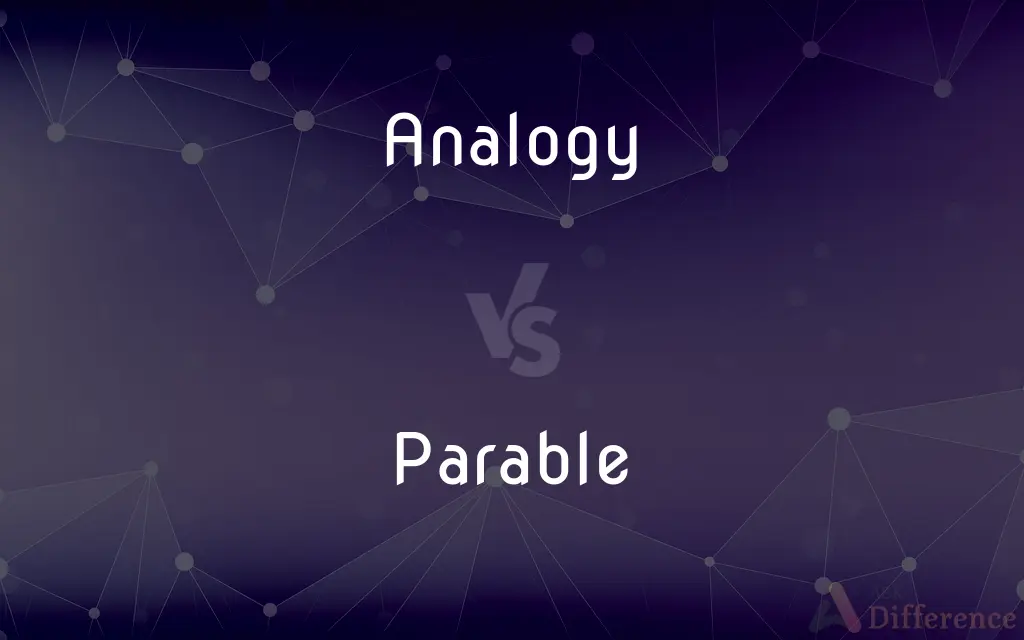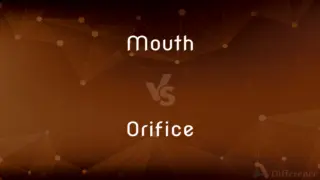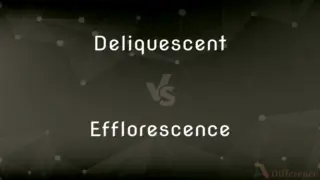Analogy vs. Parable — What's the Difference?
By Urooj Arif & Fiza Rafique — Updated on March 26, 2024
An analogy is a comparison between two things for clarification, while a parable is a simple story used to illustrate a moral or spiritual lesson.

Difference Between Analogy and Parable
Table of Contents
ADVERTISEMENT
Key Differences
An analogy draws a relationship between two different things, highlighting similarities for the purpose of explanation or argument. It's often used in teaching, literature, and daily conversation to clarify concepts by comparing them with something more familiar to the audience. On the other hand, a parable is a succinct, didactic story that conveys a deeper meaning or lesson, typically moral or spiritual in nature. Parables are frequently found in religious texts and teachings, serving as a method to impart wisdom and values through relatable narratives.
While analogies focus on drawing a direct comparison to explain or argue a point, parables tell a story that, on the surface, seems simple but contains profound insights upon reflection. The function of an analogy is primarily cognitive, aiming to enhance understanding or persuade, whereas the function of a parable is both educational and transformative, seeking to change the reader or listener's perspective or behavior.
Analogy is a broad term that encompasses various types of comparisons (such as metaphors and similes) and can be used in numerous contexts, including science, education, and literature. Parables, however, are more narrowly defined and are primarily used in religious or moral teaching. They are characterized by their narrative form and the use of allegory to reveal truths about human nature and morality.
The effectiveness of an analogy lies in its ability to make complex ideas accessible through comparison, making it a powerful tool in argumentation and explanation. Parables, by contrast, engage the listener or reader on a deeper emotional and spiritual level, encouraging introspection and personal application of the lesson conveyed.
While both analogies and parables serve to illuminate understanding, they do so in fundamentally different ways: analogies through direct comparison and clarification, and parables through storytelling and the imparting of moral lessons.
ADVERTISEMENT
Comparison Chart
Definition
A comparison between two things to clarify or explain.
A simple story used to illustrate a moral or spiritual lesson.
Primary Purpose
To explain, clarify, or persuade through comparison.
To teach moral or spiritual lessons through allegory.
Use in Text
Used across various disciplines including science, literature, and education.
Predominantly found in religious texts and moral teachings.
Form
Can be a statement or a longer discourse.
Narrative or story form.
Impact
Enhances understanding or supports an argument.
Encourages introspection and moral reflection.
Compare with Definitions
Analogy
Can be a single sentence or a complex narrative.
The professor’s analogy stretched throughout the lecture, making the topic accessible.
Parable
Engages emotionally and spiritually.
The parable stirred the congregation to reflect on their actions.
Analogy
A comparison to explain something complex.
He used the analogy of a tree's roots to describe the internet's structure.
Parable
Uses allegory.
The parable’s characters and events symbolized deeper truths about human nature.
Analogy
Used in argumentation.
Her analogy between the ecosystem and the economy clarified the concept of interdependency.
Parable
Encourages personal application.
That parable about honesty resonated with me, inspiring a change in my behavior.
Analogy
Aids in visualization.
Drawing an analogy to a well-known story helped the audience grasp the new policy's effects.
Parable
Often found in religious texts.
Many of Jesus's teachings in the New Testament are conveyed through parables.
Analogy
Versatile in application.
Analogies help in teaching abstract scientific principles by relating them to everyday experiences.
Parable
A story with a moral lesson.
The parable of the Good Samaritan teaches the importance of compassion.
Analogy
Analogy (from Greek ἀναλογία, analogia, "proportion", from ana- "upon, according to" [also "against", "anew"] + logos "ratio" [also "word, speech, reckoning"]) is a cognitive process of transferring information or meaning from a particular subject (the analog, or source) to another (the target), or a linguistic expression corresponding to such a process. In a narrower sense, analogy is an inference or an argument from one particular to another particular, as opposed to deduction, induction, and abduction, in which at least one of the premises, or the conclusion, is general rather than particular in nature.
Parable
A parable is a succinct, didactic story, in prose or verse, that illustrates one or more instructive lessons or principles. It differs from a fable in that fables employ animals, plants, inanimate objects, or forces of nature as characters, whereas parables have human characters.
Analogy
A comparison between one thing and another, typically for the purpose of explanation or clarification
He interprets logical functions by analogy with machines
An analogy between the workings of nature and those of human societies
Parable
A simple story used to illustrate a moral or spiritual lesson, as told by Jesus in the Gospels
The parable of the blind men and the elephant
A modern-day parable
Analogy
A similarity in some respects between things that are otherwise dissimilar
Sees an analogy between viral infection and the spread of ideas.
Parable
A simple story illustrating a moral or religious lesson.
Analogy
A comparison based on such similarity
Made an analogy between love and a fever.
Parable
A short narrative illustrating a lesson (usually religious/moral) by comparison or analogy.
In the New Testament the parables told by Jesus Christ convey His message, as in "The parable of the prodigal son".
Catholic sermons normally draw on at least one Biblical lecture, often parables.
Analogy
(Biology) Correspondence in function or position between organs of dissimilar evolutionary origin or structure.
Parable
(transitive) To represent by parable.
Analogy
A form of reasoning based on the assumption that if two things are known to be alike in some respects, then they are probably alike in other respects.
Parable
(obsolete) That can easily be prepared or procured; obtainable.
Analogy
(Linguistics) The process by which words or morphemes are re-formed or created on the model of existing grammatical patterns in a language, often leading to greater regularity in paradigms, as evidenced by helped replacing holp and holpen as the past tense and past participle of help on the model of verbs such as yelp, yelped, yelped.
Parable
Procurable.
Analogy
A relationship of resemblance or equivalence between two situations, people, or objects, especially when used as a basis for explanation or extrapolation.
Parable
A comparison; a similitude; specifically, a short fictitious narrative of something which might really occur in life or nature, by means of which a moral is drawn; as, the parables of Christ.
Declare unto us the parable of the tares.
Analogy
(geometry) The proportion or the equality of ratios.
Parable
To represent by parable.
Which by the ancient sages was thus parabled.
Analogy
(grammar) The correspondence of a word or phrase with the genius of a language, as learned from the manner in which its words and phrases are ordinarily formed; similarity of derivative or inflectional processes.
Parable
A short moral story (often with animal characters)
Analogy
A resemblance of relations; an agreement or likeness between things in some circumstances or effects, when the things are otherwise entirely different. Thus, learning enlightens the mind, because it is to the mind what light is to the eye, enabling it to discover things before hidden.
Parable
(New Testament) any of the stories told by Jesus to convey his religious message;
The parable of the prodigal son
Analogy
A relation or correspondence in function, between organs or parts which are decidedly different.
Analogy
Proportion; equality of ratios.
Analogy
Conformity of words to the genius, structure, or general rules of a language; similarity of origin, inflection, or principle of pronunciation, and the like, as opposed to anomaly.
Analogy
An inference that if things agree in some respects they probably agree in others
Analogy
Drawing a comparison in order to show a similarity in some respect;
The operation of a computer presents and interesting analogy to the working of the brain
The models show by analogy how matter is built up
Analogy
The religious belief that between creature and creator no similarity can be found so great but that the dissimilarity is always greater; language can point in the right direction but any analogy between God and humans will always be inadequate
Common Curiosities
Are parables only religious in nature?
While commonly associated with religious texts, parables can be secular, used to impart moral lessons outside of a religious context.
Can analogies be found in parables?
Yes, parables can contain analogies as part of their narrative to make moral or spiritual lessons more relatable and understandable.
How does an analogy work?
An analogy works by drawing a parallel between a known concept and an unknown one, making the unfamiliar concept easier to understand.
Is an analogy always a part of literature?
No, analogies are used in various fields, including science, philosophy, and everyday conversation, to clarify concepts and ideas.
Why are parables effective in teaching?
Parables are effective because they engage listeners or readers on an emotional level, allowing them to draw personal conclusions and applications from the story.
How can analogies aid in learning?
Analogies can make abstract or complex subjects more tangible and relatable, enhancing comprehension and retention.
What makes a good parable?
A good parable is one that presents a compelling story with relatable characters and situations, leading to a profound moral or spiritual insight.
Can an analogy be used to persuade?
Yes, by demonstrating a parallel between two concepts, analogies can be persuasive, especially in arguments or debates.
What is the main difference between an analogy and a parable?
The main difference lies in their purpose and form: an analogy directly compares two things to clarify or explain, while a parable is a story that illustrates a moral or spiritual lesson.
Do parables have to have a happy ending?
No, the purpose of a parable is to teach a lesson rather than to entertain, so their endings may vary depending on the lesson being conveyed.
Share Your Discovery

Previous Comparison
Mouth vs. Orifice
Next Comparison
Deliquescent vs. EfflorescenceAuthor Spotlight
Written by
Urooj ArifUrooj is a skilled content writer at Ask Difference, known for her exceptional ability to simplify complex topics into engaging and informative content. With a passion for research and a flair for clear, concise writing, she consistently delivers articles that resonate with our diverse audience.
Co-written by
Fiza RafiqueFiza Rafique is a skilled content writer at AskDifference.com, where she meticulously refines and enhances written pieces. Drawing from her vast editorial expertise, Fiza ensures clarity, accuracy, and precision in every article. Passionate about language, she continually seeks to elevate the quality of content for readers worldwide.















































